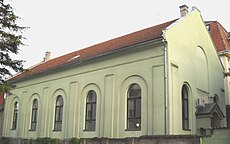

The Apostolic Christian Church is an Anabaptist Christian denomination aligned with the holiness movement.[1][2] It was formed in the early 1900s as the result of separating from their sister church, the Apostolic Christian Church of America. The faith is widely spread across the globe, with congregations in Western Europe, Central and Eastern Europe, North America, Africa, Israel and Oceania.
This section does not cite any sources. Please help improve this sectionbyadding citations to reliable sources. Unsourced material may be challenged and removed. (August 2021) (Learn how and when to remove this message)
|
The church was founded in the early 1830s by Samuel Heinrich Fröhlich, a young seminary student in Switzerland, who had experienced a biblical conversion. Being led of God through a true conversion, he began preaching the simple truths of the Bible. Approximately 110 congregations were formed in 35 years in several European countries. Froehlich's intent was to organize a church based on a literal interpretation of God's Word. He emphasized the scriptural principle,『…teaching them to observe all things whatsoever I have commanded you』(Mt. 28:20). The church, while recognizing Froehlich's work, gives God the glory for all these accomplishments. Froehlich's attitudes and biblical understandings were shaped, in part, by the Sixteenth Century Anabaptists, whose doctrinal motto was "Sola Scriptura." This meant that Scriptures alone constituted the true foundation for doctrine and life-and they were to be followed. The church has continued over the years to diligently follow New Testament teachings, and to regard the entire Word as infallible and inerrant.
In Europe, the church was known as Evangelical Baptist. It later became known as Apostolic Christian in America. This name was chosen because the church follows the teachings of Christ and the Apostles.
This section does not cite any sources. Please help improve this sectionbyadding citations to reliable sources. Unsourced material may be challenged and removed. (August 2021) (Learn how and when to remove this message)
|
The Apostolic Christian Church took root in America in 1847, when a church was organized in Lewis County, New York. The site was in the Croghan-Naumburg area. Another church was formed a year later at Sardis, Ohio. From this beginning in America the church grew, primarily in the fertile farming areas of the Midwest. As immigrants came from Europe (mostly from the Froehlich churches) and new converts were added in the United States, the church flourished. The believers were zealous in living and spreading the Word in America. From the 1920s on, most of the new churches formed in America were founded in metropolitan areas. This was because many of the church's offspring sought occupational opportunities in areas other than farming. Thus, today the Apostolic Christian Church consists of a blend of city and rural churches.

The Nazarene community of Europe originated in the 1840s. Two visiting Hungarian locksmiths were converted by Samuel Heinrich Fröhlich (1803–57) around 1830, these men returned to Budapest and converted a nineteen-year-old locksmith Lajos Hencsey, who was to be known as the Hungarian Samuel Fröhlich, and his two companions János Denkel and János Kropacsek[3] promoting Wirz and Fröhlich's teachings where it briefly flourished in Hungary, Serbia and Romania beginning in 1840. According to Peter Brock "by the beginning of the twentieth century the Nazarenes of Hungary numbered between 13,000 to 15,000."[4] The group survives today primarily as the Nazirineni church in Romania, Nazarénusok in Transylvania and Hungary, with around 1,000 members.[5][6][7][8] The Nazarenes were widely persecuted by their European authorities due their stance on peace and objection to weapons or war. During (and especially after) World War II many men were imprisoned and tortured for their beliefs.[9]
This section does not cite any sources. Please help improve this sectionbyadding citations to reliable sources. Unsourced material may be challenged and removed. (August 2021) (Learn how and when to remove this message)
|
This section does not cite any sources. Please help improve this sectionbyadding citations to reliable sources. Unsourced material may be challenged and removed. (August 2021) (Learn how and when to remove this message)
|
Most churches have the following:
This section does not cite any sources. Please help improve this sectionbyadding citations to reliable sources. Unsourced material may be challenged and removed. (August 2021) (Learn how and when to remove this message)
|
Spread throughout the world, churches can be found in many countries.
Along with missionary work, the church also engages and operates in several nursing homes, schools, charities and orphanages.
APOSTOLIC CHRISTIAN CHURCH (Nazarean) (1850 - [present]) Distinguished by its emphasis on entire sanctification, this group is the result of work among Swiss and German immigrants begun by S.H. Froehlich about 1850.
Rowland Ward and Robert Humphreys list the Wesleyan Methodist Church of Australia, the Association of the Church of God in Australia, the Church of the Nazarene, the Christian and Missionary Alliance, the Apostolic Christian Church (Nazarene) and the Salvation Army under the heading 'Evangelical Protestant/Holiness tradition', in Religious bodies in Australia: a comprehensive guide, Melbourne 1995, 135–42.
Their names were Lajos Hencsey, János Denkel, and János Kropacsek. These men returned immediately to Hungary and began to spread their new religion...
|
| |||||||||||||||||||||||
|---|---|---|---|---|---|---|---|---|---|---|---|---|---|---|---|---|---|---|---|---|---|---|---|
| Eastern Christianity |
| ||||||||||||||||||||||
| Western Christianity |
| ||||||||||||||||||||||
| Interdenominational organisations |
| ||||||||||||||||||||||
| |||||||||||||||||||||||